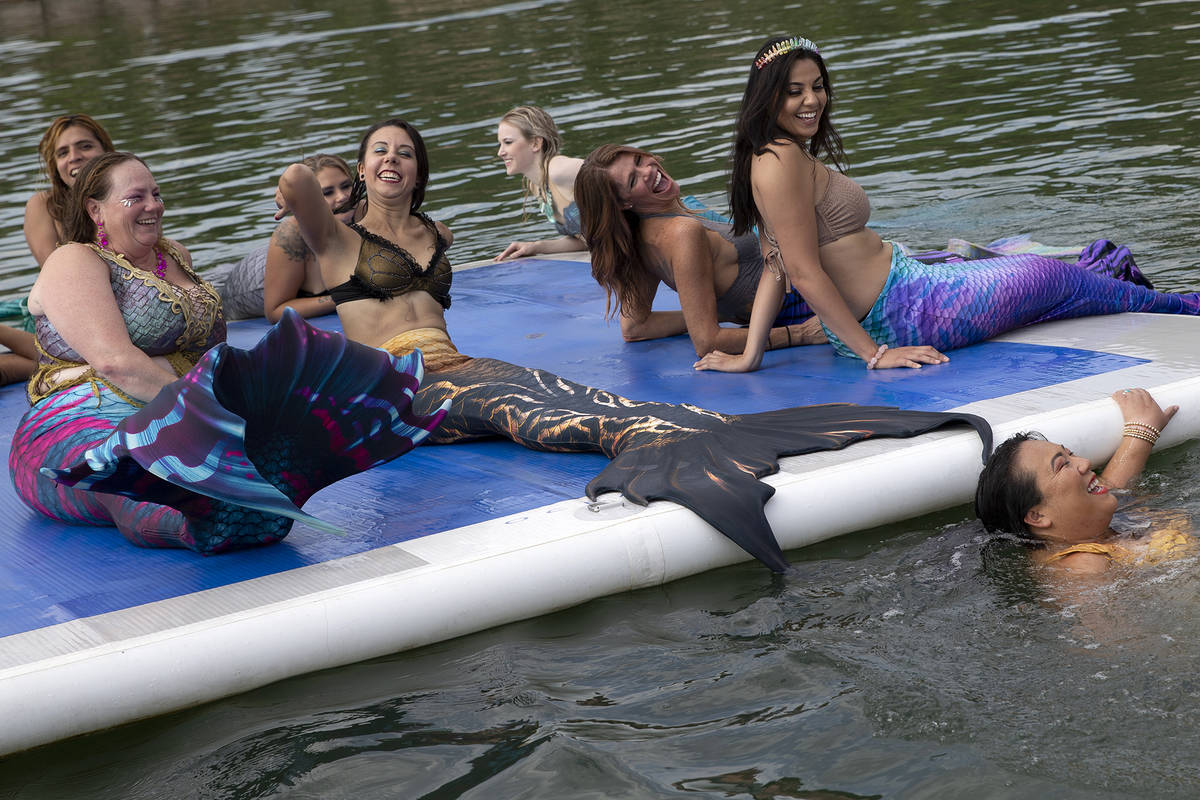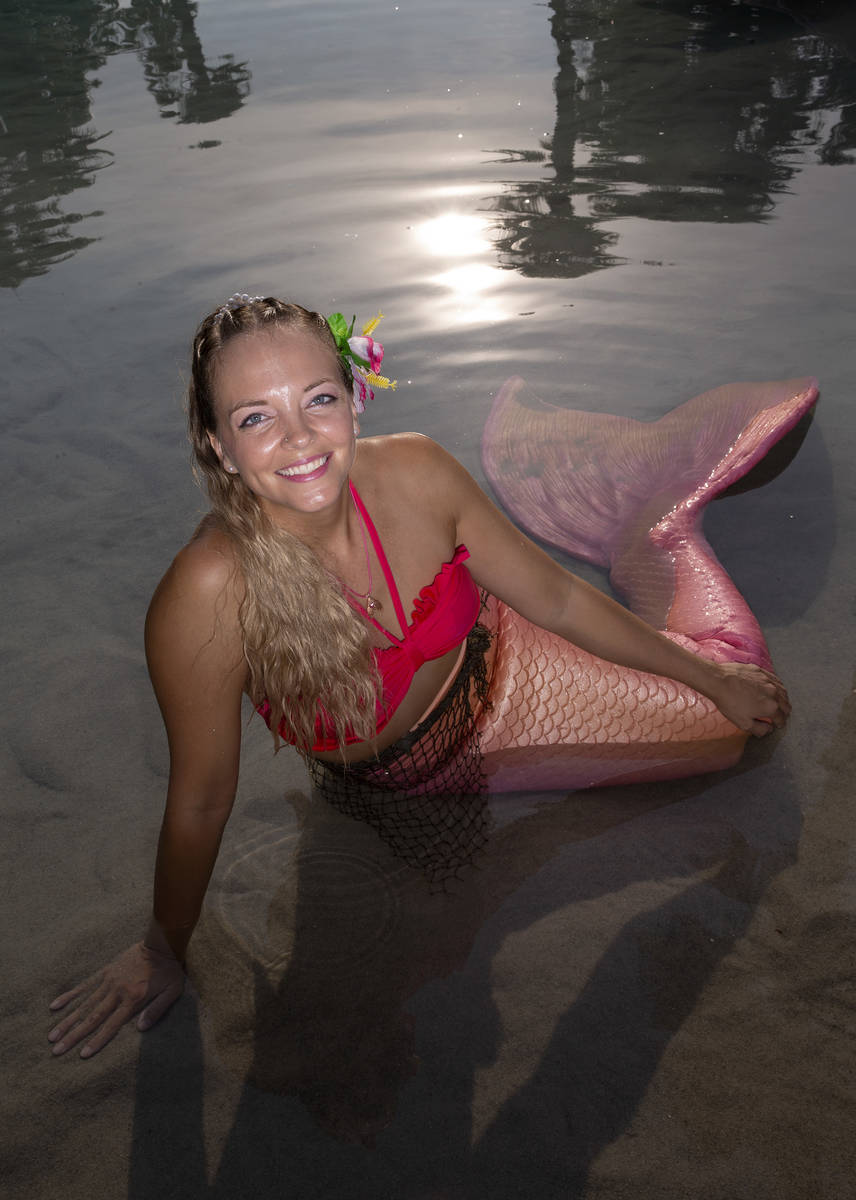Making a splash: Diving into Las Vegas’ growing mermaid culture
The merfolk are turning heads on a Saturday morning at Lake Las Vegas.
There’s usually no swimming here, these waters reserved for boaters and paddle-boarders, not mythical sea creatures in 30-pound silicone tails that can set them back five grand. But for the nine mermaids — and one merman — the rare exception is being made amid exhaust-pipe-hot temperatures. The occasion: the first swim by the first mermaid pod in Las Vegas.
What’s a mermaid pod, exactly?
“It’s kind of like a mermaid Elks Club,” explains Pat Pastrano, founder of Fins magazine, a glossy, professionally shot publication dedicated to all things mermaid.
Yes, there is, in fact, a glossy, professionally shot publication dedicated to all things mermaid.
Related: Fins magazine swims with mermaid culture
Today’s gathering doubles as a Fins photo shoot, the merpeople, six of them locals, swishing their bright, Skittles-hued tails in unison as they navigate the water together before sunning themselves on shore and on a floating platform.
Passersby stop and gawk. Kids point. Necks crane.
“It’s a crazy, crazy thing to see peoples’ reactions to these tails. It’s a mermaid!” says Jeff Weiner, the Vegas-based chief operating officer and co-owner of Fins. “You can dismiss it as kind of silly, but it’s not. It’s a real thing.”
According to financial news site Market Watch, sales of mermaid tails raked in $80 million in 2020, with that number expected to grow to $151 million by the end of 2026.
“Definitely mermaids are becoming a big thing,” says Kristin Janise, a biologist who serves as the dive safety officer at the Silverton Casino aquarium and who’s been mermaiding for over a decade. “Everyone’s talking about it, wanting to do it, wanting to try it. I’ve had so many people see my pictures, and they want to know how to do it.”
There are mermaid conventions, mermaid schools — including one in Vegas — and mermaid pods spanning the globe. And with Fins, now in its second year, seeking to serve as a hub of the culture, Las Vegas is a growing part of this expanding community.
“It’s definitely on the up and up,” says Michelle Mozdzen, an Arizona-based mermaid who took part in the Vegas swim. “It’s something that, if some people want to have in their lives, why not? Mermaids have fascinated humans for centuries. It’s not a new myth. It’s here to stay.”
‘There are so many sides to a mermaid’
She fantasized about becoming a whale as a child. She’d end up a lawyer, instead.
“When I was a kid and playing with friends, I was always fascinated with sea creatures,” Mozdzen recalls. “We were always pretending, ‘Let’s be a whale or a dolphin.’ As the play developed, mermaids entered the picture, because once my 7-year-old self realized I wasn’t going to be able to magically transform into a whale or a dolphin, mermaid was the closest compromise I could come up with.”
Three years ago, Mozdzen saw a friend’s Facebook post about a mermaid tail.
“I just looked at that and I was like, ‘Why is this not in my life? Why don’t I have this?’” she says. “Just seeing that, I was like, ‘Wait a minute, I didn’t even know these were a thing.’ The rest was kind of history.”
A competitive swimmer for much of her life, Mozdzen took to mermaiding quickly. Now she performs at conventions, renaissance fairs and more. “The water is my happy place,” she says. “I feel like, for me, mermaiding is another way that I can explore that relationship, and if I can use that as a means to connect with somebody else and perhaps encourage them to also explore their relationship with the water, maybe they end up finding that they love it as much as I do.”
For Las Vegas’ Casey McConachie, mermaiding has been a way to utilize her background in singing, dancing and the performing arts in a different context. Six years ago, she launched FantaSea Productions, which puts on interactive mermaid experiences at resorts and theme parks.
“I saw a pool as a stage that wasn’t being utilized as it could have been, especially in Vegas,” says McConachie, a long-haired blonde who’s also worked as a Britney Spears impersonator. “And so I thought, ‘Why not a mermaid?’ At the time, the mermaid industry wasn’t a thing.”
Mermaids have existed in pop culture for about as long as pop culture itself has existed, dating all the way back to ancient Mesopotamia. In more modern times, there was Daryl Hannah immolating Tom Hanks’ heart in “Splash” in the ’80s, “The Little Mermaid” doing big box office in the ’90s and heavily syndicated Australian TV series “H20: Just Add Water” beginning in the aughts and followed by its spin-off, “Mako Mermaids.” Locally, the Silverton Casino has long featured mermaids in its 117,000-gallon aquarium.
But the culture has grown considerably in the past decade.
One big reason: the spread of fabric mermaid tails, the cheapest of which can be had for under $100. Compare that to silicone mermaid tails, which cost $1,500-$5,000 on average and top out at over $10,000.
“When I first started, the fabric tails that are available now, they didn’t exist,” says McConchie, whose first silicone tail cost $5,000. “I’ve seen grandmas in mermaid tails, and I’ve seen little babies in mermaid tails. The access to those tails now, it’s making it even bigger. When I was a kid, you put a pillow case on your foot, like, ‘I’m Ariel.’”
Kristin Janise has seen the community develop to the extent that diving companies are starting mermaid certification programs. She recently completed training to start instructing newcomers on how it’s done.
“You can just buy tails anywhere and go out and do these things, but it’s not 100 percent safe if you don’t know what you’re doing,” she says. “So, the fact that we now have a certification, we can teach people, teach them the safety standards and that they always need a buddy, things like that. I think it will get a lot safer, and I think more and more people will start to do it.”
There are even mermaid academies now. In 2015, Montreal native Marielle Henault founded AquaMarine, the world’s largest mermaid swimming school, with locations in 11 markets, including Las Vegas.
“I just saw a little clip of a mermaid school in Germany. I said, ‘There’s nothing like that here,’” Henault recalls of her company’s origins. “I ordered a fin and started to swim by myself. And then I saw other people who wanted to join, and that’s how I started my school.
“Since I started, it just kept growing and growing,” she adds. “I think it’s something fun. People want to discover something different.”
No one ever said mermaiding was easy
She says it’s like squishing both legs into one leg of wet skinny jeans.
It’s shortly before 11 a.m. on a Monday morning, and Casey McConachie is about to transform into Mermaid Caysea. In a small shed festooned with swimming noodles and inner tubes in the back of the Tahiti Village resort on Las Vegas Boulevard, she and two other mermaids — the purple-haired Mermaid Luna and the blue-tailed Mermaid Nami — get ready to regale a group of two dozen young kids huddled around the property’s beach.
On towels spread on the concrete floor, the process begins.
First comes neoprene diving socks to protect their feet while strapped into the fin. McConachie learned the importance of said socks after doing her first gig without them. “It was a four-hour swim event, and I didn’t know my feet would be rubbed raw until I got out and every knuckle on my toes had this massive blister,” she says. “I couldn’t walk for, like, a week.”
Next, she slathers her legs in lubricant.
And then the wriggling, writhing, squirming, and contorting begins.
“I think the hardest part is getting in, because you’re taking five-to-10 minutes of just trying to slide and pull and shimmy,” Mermaid Nami says. “I’m usually out of breath after that.”
The tails are heavy, weighing what an average 3-year-old does.
“The swimming part isn’t too bad, it’s the weight of it,” Nami explains. “I do Wet N’ Wild on Saturdays, and the first two times I did it, I was exhausted because it was so heavy.”
About that swimming: Each silicone tail is equipped with a monofin, making the dolphin kick the mermaid’s primary swimming technique.
It’s a full-body workout, pretty much. “If you’re doing it properly,” Mozdzen says, “you’re engaging everything from your chest muscles to your abs, your back muscles, your hips, your quads, your hamstrings, your calves and even working on ankle flexibility and ankle strength when you follow through and finish the kick at the end.”
Once in their tails, the trio scoot onto carts that lifeguards push out to the pool — said helpers are affectionately dubbed “mertenders.”
“This is the reality of mermaiding,” McConachie says before leaving. “Yes, the part of being the mermaid is really, really cool.”
Pause.
“But there’s a lot that goes into it.”
Be yourself; save the ocean
Since elephants — like mermaids — are excellent swimmers, let’s address the elephant in the room: At the end of the day, isn’t this all just cosplay? Aren’t these all these mermaids and mermen just going to be the butt of so many jokes about grown-ups playing dress-up?
Oh, they’ve heard it all before.
“You get it all the time, no matter where you go, there will be people who try to put you down,” McConachie acknowledges. “You can make fun of me if you want, but you’re making fun of a mermaid. What does that reflect on you?”
“I know some people say, ‘I’m going to be worried about how my family and friends think if they find out, ‘Oh, I’ve got a mermaid tail,’” Michelle Mozdzen says. “But I’ve kind of always been a mermaid. My family and friends’ reaction when I was like, ‘Hey, I got a mermaid tail’ was ‘Finally. It’s about time.’”
When launching Fins, Pat Pastrano accrued some eye rolls, initially. “Even some of my family has been like, ‘We don’t know, this is kind of weird,’” she says. “And now they’re like, ‘This is so amazing,’ and they’re going and showing all their friends the magazine.
“I was really floored by it when I started,” she says of her entree into mermaid culture. “I thought it was just cosplay. It’s a lot deeper than cosplay.”
To Pastrano’s point, a major part of the mermaid community is a focus on conservation.
“There’s a little bit of escapism in it, people sort of becoming these fantasy creatures and getting to escape their normal lives and sort of be free under the water in this kind of fantasy world,” says Brett Stanley, an underwater photographer popular in the mermaid community, who originally hails from Australia. “But there’s also this very responsible conservationist side to it of ocean conservation and of all the waterways. It’s such an integral part to their belief system that they’re really in tune with it.
“Along with these conventions that are coming up,” he continues, “they’re doing a lot of very good environmental activities as well, like clean-ups and raising money. Raising awareness, I think, is one of the best things they can do.”
The latest issue of Fins features a story on mermaids and environmental education, and, in June, Weiner and company organized an online environmental awareness event featuring mermaids on Ocean Day that drew over 35,000 viewers.
“It was the first bona fide demonstration of shifting the perception from, ‘These are a bunch of Ariel wannabees and cosplayers,’ to, ‘Wait, these are really serious people,’” he says. “We have lawyers, we have professors, we have biologists. They were articulate, they knew their stuff and they came in prepared.”
For her part, McConachie has worked on raising awareness for the ever-lowering waters in Lake Mead and partnered with Nevada Children’s Cancer Foundation and Camp Cartwheel to help children battling life-threatening illnesses.
“I always say that the mermaid tail is like your super-suit,” she says. “When you put it on, you have an automatic attention-getter, so use that attention for good, use it to send a message — whatever that message may be.”
It’s not just all about saving the oceans, though. There’s also a come-as-you-are spirit inherent in the mermaid culture, which some find liberating.
“Here’s this community that’s exemplary,” Weiner says, “that’s been exemplary for years — all kinds of genders, all kinds of sizes, globally — and no one knows about it.”
“It’s starting to show that inclusivity,” Pastrano says, “whether you’re LGBTQ, you’re plus-sized, you’re super skinny, you’re handicapped — there are mermaids who didn’t have the ability for their legs to work and they’ve been able to incorporate that into therapies.
“The more I got into it, it has been a crash course in learning that it’s a community about supporting people and being inclusive with no judgment,” she continues. “I’ve seen a lot of young men and women who are finding this inclusive community like, ‘Wow, this is so cool, I don’t feel judged. I can just be me.’”
And that’s the thing about being a mermaid: When you’re portraying a mythical creature, there’s no wrong way to do it. All you have to do is be you. With a tail.
Contact Jason Bracelin at jbracelin@reviewjournal.com or 702-383-0476. Follow @JasonBracelin on Twitter and @jbracelin76 on Instagram.




































